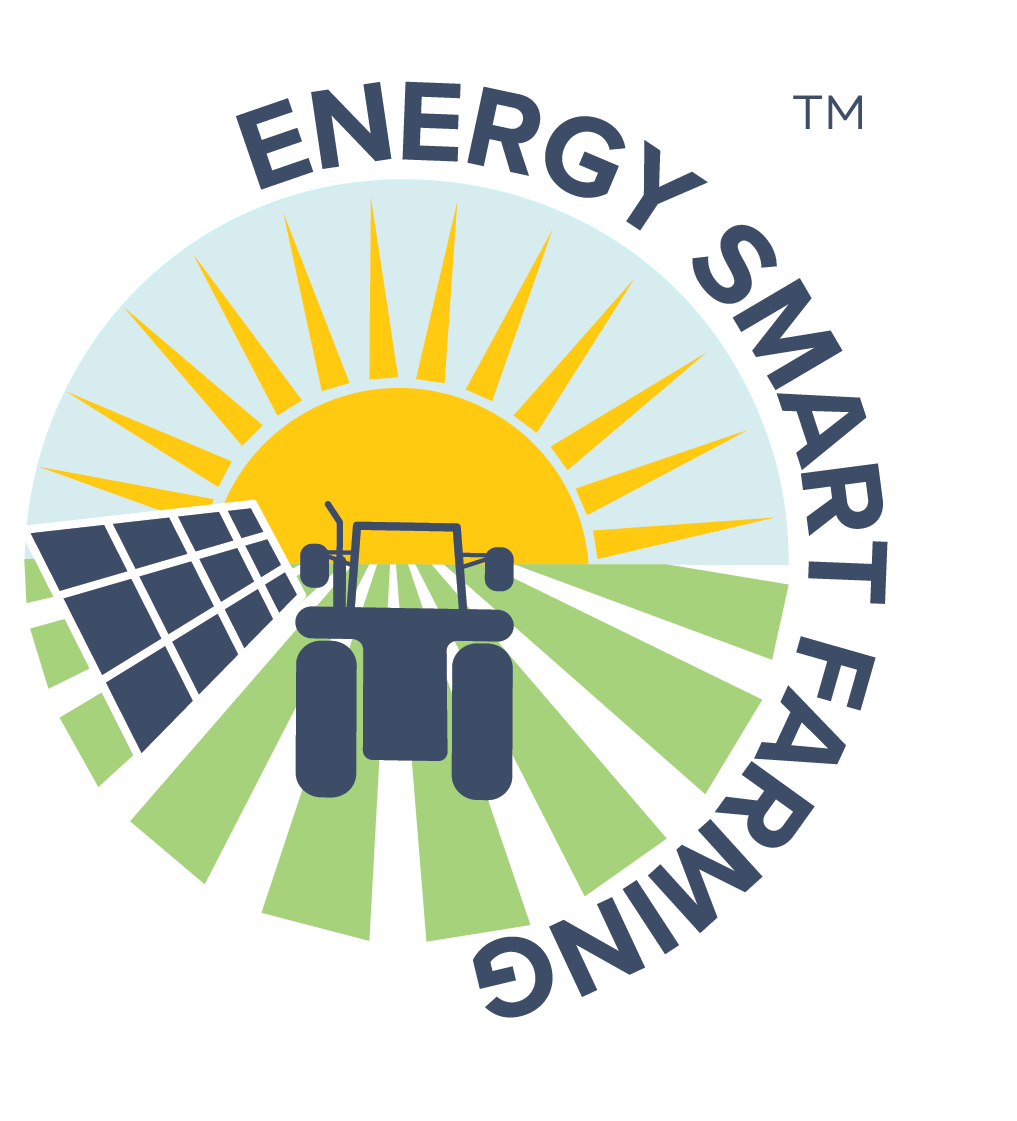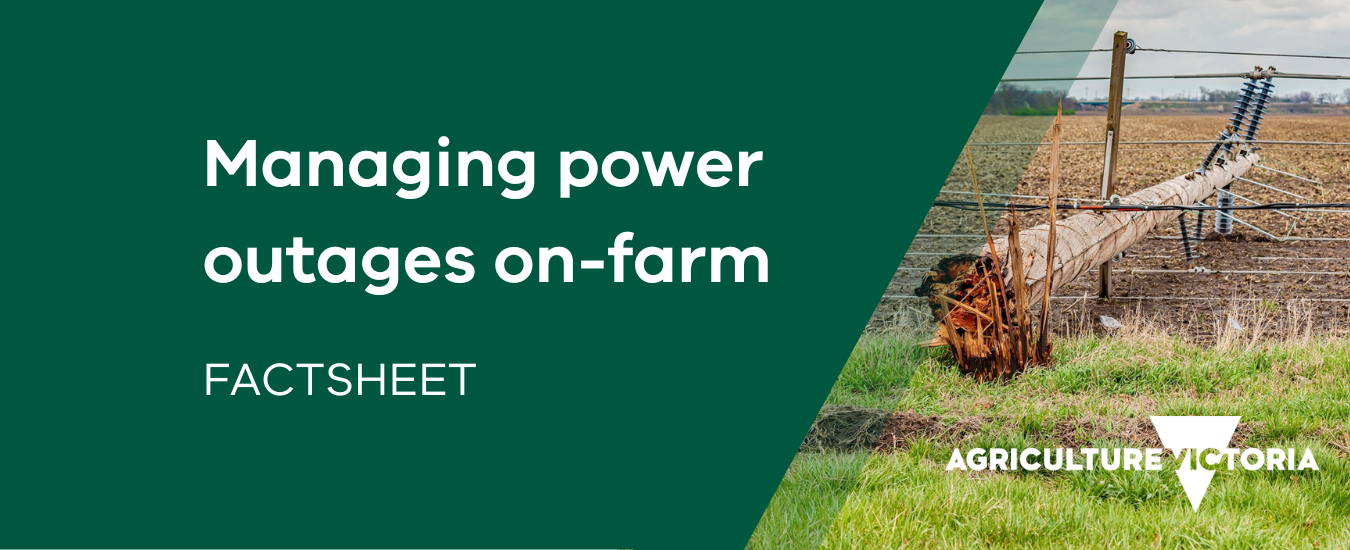The loss of power to farms can cause the failure of critical infrastructure including livestock water systems, electric fences, milk-harvesting equipment, automated feeding systems, heating or refrigeration, and irrigation systems. The failure of one or more of these systems can cause economic losses and have impacts on animal welfare.
This technote assists producers to prepare for and manage power outages on-farm. It contains information on:
- planning before a power outage
- during a power outage
- considerations for specific industries
- generators
- battery storage
- electricity distributors.
Planning before a power outage
Planning and preparation are key to reducing the economic risk of power outages. The aim is to enable farm operations to continue with minimal interruption, reducing production and animal welfare impacts.
Develop a power outage plan
Firstly, identify energy-reliant infrastructure, which is critical to your business. For example:
- electric fencing to safely contain stock
- water pumps to maintain water supply
- milk harvesting and cooling equipment on dairy farms
- feed processing and feeding systems
- refrigeration
- ventilation systems in housed animal systems that manage temperature and air quality.
After identifying the infrastructure and systems required, develop a plan of how you are going to maintain operations in the event of a power outage.
Ensure the plan has been documented and discussed with everyone on the farm, especially family members and employees, and provide training on the process of prioritising and operating the critical systems during a power outage. If possible designate and distribute emergency responsibilities among employees and family members. This will assist to spread the load and prevent overwhelming any one person.
Information to include in the plan and cover in the training:
- contact details for the farm owner or manager
- electricity Meter Number and National Meter Identifier (the NMI can be found on your electricity bill).
- a list of emergency contact numbers, such as:
- energy retailer and distributor
- electrician
- SES and CFA
- veterinarian
- milk processor
- action required by the staff or manager during the power outage. Having this in a checklist format may be useful
- the process to shut down equipment in a power outage
- the safe operation of equipment on backup power.
Housed and intensive livestock industries often include energy and backup power preparation in industry guidelines specific to the industry needs.
Practice your power outage plan with staff to ensure the plan works and modify it when needed.
Consider livestock food and water systems
During a power outage, the farm’s electrically powered feeders will not operate without a backup power source. Identify alternative methods to feed your animals if the equipment does not work and consider backup power for these systems.
Waterlines or pumps may be operated by mains power:
- identify alternate water sources, which animals can access, such as a dam, or have containers and a way to transport water to animals
- consider installing new pumps or retrofitting existing ones that allow connection to a generator
- for information on water management and water requirements of different types of livestock go to: https://agriculture.vic.gov.au/farm-management/water/farm-water-solutions/managing-farm-water-supplies
Have a dependable and adequate backup power source
Work with your electrician to determine your power needs and the best backup systems for your farm. This may include a generator, a solar and battery system, or a combination of both. See the information below in this factsheet under Generators and Battery Storage sections.
Be prepared
To ensure your farm is ready to respond to a power outage, you may also want to consider:
- having a minimum of two to three days of fuel supply to operate generators and essential equipment
- having mobile phone chargers and power banks accessible. Be aware mobile phone towers only have 24 hours of backup power available
- place torches and spare batteries in key locations
- install surge protectors on electrical equipment
- for critical infrastructure install an uninterruptible power source (UPS). These provide power when the power source fails before the backup power source takes over
- prepare a list of equipment that should be turned off or unplugged when power fails.
During a power outage
Backup power
Implement backup power options – such as generator and battery storage. More information is provided below in the Generator and Battery Storage sections.
Equipment safety
To prevent damage from electrical surges or spikes when power is restored turn off or unplug previously identified equipment.
Housed livestock including dairy cattle, pigs, poultry
During a power outage, housed livestock are impacted more than grazing livestock, with electric feeders or water lines inoperable. Ventilation systems will be down which can increase the temperatures and levels of ammonia and other toxic gases. To manage this:
- ensure your backup power e.g. generators, are operating
- ensure adequate air movement is maintained and if required open vents ensuring any debris has been removed. In poultry sheds use knock-out panels to increase ventilation.
After a power outage
It is advised that when mains power returns, the backup power source is kept in place for a period of time. This is to reduce the impact of interruptions and surges which can be caused as your utility provider works to restore the service.
- Check equipment and appliances for damage or failures which may have occurred
- Always have a licensed electrician check electrical installations following flood or storm damage
- Assess loses which may have occurred, making sure you review your insurance coverage and follow the insurance company’s procedures for initiating any claims.
An important step, but often forgotten, is to hold a debrief to review the actions taken during the outage. A debrief allows you to discuss the actions which worked well and identify if changes or improvements are needed to the power outage plan.
Considerations for specific industries
Dairy
The impact of power outages on dairies can have a significant impact on animal health and productivity. Therefore, an alternative power supply is critical.
- If a power failure occurs, contact your milk processor field officers to advise them if the milking schedule is disrupted or of the inability to cool milk.
- If required, request hot milk pick-ups or increase pick-up frequency from your processor to reduce the risk of spoilage and reduce the energy required for milk cooling.
- If you need to undertake emergency disposal of milk, follow the methods outlined by Agriculture Victoria at https://agriculture.vic.gov.au/livestock-and-animals/dairy/managing-effluent/emergency-disposal-of-milk
- If you cannot source an alternative power supply, consider arranging to milk cows at a neighbouring property with a power supply, if practical and safe to do so. More information on key considerations of milking at a neighbouring property including milk quality, animal health and vaccinations can be found in Dairy Australia’s factsheet on cow parking: https://www.dairyaustralia.com.au/resource-repository/2020/09/01/cow-parking-factsheet
- If you are considering milking on a neighbouring property, ensure the movement is recorded on the NLIS database as well as completing vendor declarations or waybills.
- If you are considering generators or a solar battery system speak to your electrician or equipment supplier to understand the energy requirements of the milking plant components and to develop a loading schedule for these systems.
- If you operate a rotary or rapid exit dairy, as part of your plan consider how to allow cows to exit the dairy if a power outage occurs during milking. Speak to the installer or equipment supplier to determine how to allow the cows to be removed.
Dairy Australia has a range of resources to assist farmers through extreme weather events including power outages: https://www.dairyaustralia.com.au/issues-and-emergencies/extreme-weather
Poultry
Under the Egg Industry Environmental Guidelines and the National Environmental Management System for the Meat Chicken Industry – Version 2 standby generators with auto-switch control are required to manage power supply failures.
This is necessary to maintain a constant supply of water, feed delivery, lighting, and ventilation (particularly fans). Poultry deaths can occur during hot weather with only minimal interruptions to ventilation and cooling equipment.
- Automatic control is essential as power disruptions and total failure can occur at any time.
- These systems should be regularly run (at least fortnightly) to ensure they are working effectively.
- Tunnel ventilated sheds with solid sides may have knockout panels, which can be manually opened in the event of complete power failure (i.e., generator also fails to start).
- Consider the energy requirements for possible future expansion of the facilities.
Further information is available at:
- https://www.australianeggs.org.au/assets/dms-documents/Egg-industry-environmental-guidelines.pdf
- https://www.agrifutures.com.au/wp-content/uploads/publications/14-100.pdf
Horticulture
The impact of power outages can cause a range of issues for the horticultural industries.
The need to irrigate may be critical depending on the type of operation, time of the year, temperature and soil moisture.
- Work with your electrician to determine the size of generator required to power irrigation pumps and irrigation system.
Farm-based GPS base stations are often supplied by mains power. Without power-controlled traffic farming (CTF) operations (ploughing, spraying, or harvesting) will not be able to occur.
- Consider if a generator can be wired to provide power.
Due to the power required to operate packing lines and/or cool rooms, generators of sufficient size are hard to source or may not be financially feasible. To manage this:
- speak to other packers or growers, if you can use their packing lines and employees if a power outage occurs
- determine if you can use cool rooms nearby
- hire a refrigerated shipping container or truck trailer as a temporary measure.
Consider installing solar panels and batteries as a backup power supply option.
Cattle and sheep
Feedlot operations are highly reliant on energy, to provide feed and water to livestock, manage waste (including pen cleaning, manure treatment and effluent management) and administration and operation of the facility.
It is recommended that backup generators are available and correctly sized to manage the economic, social and animal welfare consequences of electric power disruptions.
Further information is available at:
Generators
The backup or supplementary power supply is often a critical component of any power outage plan. However, the first step is to determine how much power is required to operate your critical infrastructure.
The key to this process is to engage your licensed electrician or electrical engineer, to assist in determining your energy requirement.
Key questions to ask when speaking to the electrician:
- what phase is your electrical supply: single phase or three-phase?
- the generator size needed to operate your equipment?
- what voltage is your service: 208V, 240V or 480V?
- how do you connect the generator?
- is a Wye or Delta generator needed?
- where is the best placement for the generator?
- how many kW are needed to run your critical systems?
- the amount and size of cabling required
- remember, appliances with motors will use three to four times their running rating while they are starting up the start-up order for equipment to ensure the generator is not overloaded with the higher start-up loads.
Hiring generators
Many producers consider hiring generators during power outages, the key questions above apply even if you are hiring.
Further considerations around hiring generators:
- it may be difficult to source an appropriately sized generator (domestic generators won’t do the job)
- an electrician may be required to safely connect or disconnect the generator
- changeover switches need to be installed to switch supply from the mains to the generator, these need to be installed by a licensed electrician
- during a power outage electricians could be in short supply
- wiring and onboarding cost
- need solid footing for the generator (concrete floor) in a well-ventilated area
- risk of generator burn-out if overloaded, this may result in paying excess fees to the hire company
- operator safety, generators may differ between each power outage, your staff on-farm may not be trained to operate the hired generator.
Intensive industries or dairy operations
Some farming operations will be energy-intensive; consideration is needed to determine if a full-load or part-load generator/s are required. A full-load generator is sized to handle all the energy requirements in use in the area e.g., dairy shed, piggery shed. Part-load generators are smaller and only the most essential equipment is operated at one time e.g. the milking harvest equipment and hot water are operated separately.
Preparing your generator
Only purchase or operate a generator that complies with Australian Standard AS2970. Before operating read the manufacturer’s instructions.
- Ensure the generator is earthed according to the manufacturer’s recommendations.
- The installation of light or lamp, which is connected to the mains power line between the meter and the transfer switch, aids in determining when mains power has failed and when it has been restored.
Operation
If your generator has an automatic start, the generator will start automatically when a power outage occurs and stops when the power is restored. However, most generators will have a manual start. Therefore, owners should follow the manufacturer’s recommended operation and start procedure.
- Start the unit and bring the generator up to the manufacturer’s recommended operating voltage before commencing the operation of electrical equipment.
- Follow your plan by starting the largest electrical motor first, adding other loads when each is up to operating speed. Do not add too much too fast.
Safety
A generator must be correctly sited for safety. Generators should be placed on concrete surfaces and only operated in well-ventilated areas. This is to prevent carbon monoxide poisoning, which can cause loss of consciousness and death. Look out for the common symptoms of carbon monoxide poisoning including headache, dizziness, weakness, nausea, vomiting, chest pain, and confusion.
Other safety considerations:
- switch the generator off when refuelling or not in use
- avoid naked flames or using ignition sources near generators. Smoking should not be permitted around generators
- make sure all generator openings are clear. A cover made of 6 mm (1/4 inch) galvanized wire mesh will prevent damage by rats and mice
- use battery-operated light sources, flashlights or glow sticks around the generator, in case of spilt fuel
- the installation of circuit breakers on the generator, or between it and the transfer switch, will protect the generator against overload damage
- install a surge arrester with the transfer switch to protect the generator as well as the circuits, appliances, and motors served by that switch
- if choosing a power take off (PTO) generator, ensure the tractor has no fuel or oil leaks to prevent fire hazards.
Battery Storage
Battery storage often combines an energy source, commonly solar, with batteries. Battery systems can store the power generated from the energy source and supply it in times of need.
Just like choosing a generator, the key is to determine how much power is required to be supplied to your critical infrastructure.
- Examine energy consumption over a 24-hour and 365-day cycle when choosing a battery system
- Is the battery going to run the whole-of-business backup (full-load, this supplies power to everything) or for essential load backup, (part-load, by isolating certain circuits to power essential equipment)?
Do you have an appropriate location to install the battery? Talk to your electrician/installer about the requirements of Australian Standard AS5139.
For more information, if you are considering batteries visit the Clean Energy Council: https://www.cleanenergycouncil.org.au/
Electricity distributors
For more information on power outages, phone your local electricity network service provider or visit their website:
- western suburbs and western Victoria: Powercor Australia on 13 24 12 or https://www.powercor.com.au/
- northern and north-western suburbs residents: Jemena on 13 16 26 or https://jemena.com.au/
- outer northern and eastern suburbs and eastern Victorian’s: Ausnet Services on 13 17 99 or https://www.ausnetservices.com.au/
- southern suburbs and Mornington peninsula residents: United Energy Distribution on 13 20 99 or https://www.unitedenergy.com.au/
Disclaimer
This publication may be of assistance to you but the State of Victoria and its employees do not guarantee that the publication is without flaw of any kind or is wholly appropriate for your particular purposes and therefore disclaims all liability for any error, loss or other consequence which may arise from you relying on any information in this publication.



